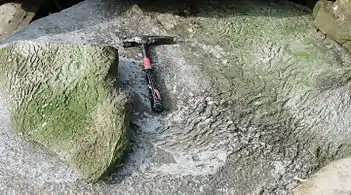Microbially induced sedimentary structure
Microbially induced sedimentary structures (MISS) are primary sedimentary structures formed by the interaction of microbes with sediment and physical agents of erosion, deposition, and transportation.[2][3][4][5] The structures commonly form when microbial mats (which may comprise bacteria, fungi, protozoans, archaea or algae) are preserved in the sedimentary geological record.[6] There are 17 main types of macroscopic and microscopic MISS.[7] Of those, wrinkle structures [8] and microbial mat chips are the most abundant in the fossil record. Other MISS include sinoidal structures, polygonal oscillation cracks, multidirected ripple marks,[9] erosional remnants and pockets, or gas domes.

Although these structures have only recently been named and systematically described, links between microbes and distinctive structures in sediments and sedimentary rocks have been suggested by several early workers.[1][10][11][12] MISS have been identified in beds formed 3,480 million years ago in the Archean[13][14] and may be the oldest complete fossils on Earth.[7][13][14] In the Ediacaran period, they are often associated with the preservation of fossils of the Ediacara biota; subsequent to this point their prevalence declines as a result of the Agronomic revolution[7][15][16][17]
A number of criteria have been proposed for recognising genuinely biological structures, and discriminating them from similar-looking features that can arise through geological processes. These relate to the extent of metamorphism to which the rocks have been subjected; their stratigraphic position with respect to sea-level; their depositional environment; their relationship to ancient hydraulics; and their texture.[6]
Individual studies on microbial mat-induced sedimentary structures are summarized and illustrated in several recent books, including Atlas of microbial mat features preserved in the siliciclastic rock record [18] and Microbial Mats in Siliciclastic Depositional Systems Through Time.[19]
According to a study on the planet Mars, there may be sandstone beds, associated with the Gillespie Lake Member of Yellowknife Bay, visited by the Curiosity rover, that are similar to MISS on Earth.[20]
See also
References
- Manten, A. (1966). "Some problematic shallow-marine structures". Marine Geology. 4 (3): 227–669. Bibcode:1966MGeol...4..227M. doi:10.1016/0025-3227(66)90023-5. hdl:1874/16526.
- Noffke, N.; Gerdes, G.; Klenke, T.; Krumbein, W. E. (2001). "Microbially Induced Sedimentary Structures: A New Category within the Classification of Primary Sedimentary Structures". Journal of Sedimentary Research. 71 (5): 649. Bibcode:2001JSedR..71..649N. doi:10.1306/2DC4095D-0E47-11D7-8643000102C1865D.
- Noffke, N., 2003, Microbially induced sedimentary structures, in Middleton, G.V., ed., Encyclopedia of Sediments and Sedimentary Rocks: Boston, Kluwer Academic Publishers, p. 439-440.
- Noffke, N. (2008). "Turbulent lifestyle: Microbial mats on Earth's sandy beaches—Today and 3 billion years ago". GSA Today. 18 (10): 4–9. doi:10.1130/GSATG7A.1.
- Noffke, N.; Krumbein, W. E. (1999). "A quantitative approach to sedimentary surface structures contoured by the interplay of microbial colonization and physical dynamics". Sedimentology. 46 (3): 417. Bibcode:1999Sedim..46..417N. doi:10.1046/j.1365-3091.1999.00218.x.
- Noffke, N. (2009). "The criteria for the biogeneicity of microbially induced sedimentary structures (MISS) in Archean and younger, sandy deposits". Earth-Science Reviews. 96 (3): 173–180. Bibcode:2009ESRv...96..173N. doi:10.1016/j.earscirev.2008.08.002.
- Noffke, N., 2010, Microbial Mats in Sandy Deposits from the Archean Era to Today: Springer Verlag, Heidelberg, 193 p.
- Hagadorn, J.W.; Bottjer, D.J. (1999). "Wrinkle structures: Microbially mediated sedimentary structures common in subtidal siliciclastic settings at the Proterozoic-Phanerozoic transition". Geology. 25 (11): 1047–1050. doi:10.1130/0091-7613(1997)025<1047:WSMMSS>2.3.CO;2.
- Noffke, N (1998). "Multidirected ripple marks arising from bacterial stabilization counteracting physical rework in modern sandy deposits (Mellum Island, southern North Sea)". Geology. 26 (10): 879–882. doi:10.1130/0091-7613(1998)026<0879:mrmrfb>2.3.co;2.
- Riding, R. (2007). "The term stromatolite: towards an essential definition". Lethaia. 32 (4): 321–330. doi:10.1111/j.1502-3931.1999.tb00550.x. Archived from the original on 2015-05-02.
- Pratt, B.R., 2003, Stromatolites, in Middleton, G.V., ed., Encyclopedia of Sediments and Sedimentary Rocks: Boston, Kluwer Academic Press, p. 688-690.
- Gerdes, G. and Krumbein, 1987, Biolaminated deposits: Springer, Heidelberg, 169 p.
- Borenstein, Seth (13 November 2013). "Oldest fossil found: Meet your microbial mom". AP News. Retrieved 15 November 2013.
- Noffke, Nora; Christian, Christian; Wacey, David; Hazen, Robert M. (8 November 2013). "Microbially Induced Sedimentary Structures Recording an Ancient Ecosystem in the ca. 3.48 Billion-Year-Old Dresser Formation, Pilbara, Western Australia". Astrobiology. 13 (12): 1103–24. Bibcode:2013AsBio..13.1103N. doi:10.1089/ast.2013.1030. PMC 3870916. PMID 24205812.
- Noffke, N.; Paterson, D. (2007). "Microbial interactions with physical sediment dynamics, and their significance for the interpretation of Earth's biological history". Geobiology. 6 (1): 1–4. doi:10.1111/j.1472-4669.2007.00132.x. PMID 18380881.
- Noffke, N.; Awramik, S. M. (2013). "Stromatolites and MISS—Differences between relatives". GSA Today. 23 (9): 4. doi:10.1130/GSATG187A.1.
- Callow, R. H. T.; Brasier, M. D. (2009). "Remarkable preservation of microbial mats in Neoproterozoic siliciclastic settings: Implications for Ediacaran taphonomic models". Earth-Science Reviews. 96 (3): 207–219. Bibcode:2009ESRv...96..207C. CiteSeerX 10.1.1.426.2250. doi:10.1016/j.earscirev.2009.07.002.
- Schieber et al., eds., 2007, Atlas of microbial mat features preserved in the siliciclastic rock record: Elsevier, 324 p.
- Noffke, N. and Chaftez, H., 2012, Microbial Mats in Siliciclastic Depositional Systems Through Time: SEPM Special Publication 101.
- Nora, Noffke (February 14, 2015). "Ancient Sedimentary Structures in the <3.7 Ga Gillespie Lake Member, Mars, That Resemble Macroscopic Morphology, Spatial Associations, and Temporal Succession in Terrestrial Microbialites". Astrobiology. 15 (2): 169–192. Bibcode:2015AsBio..15..169N. doi:10.1089/ast.2014.1218. PMID 25495393.